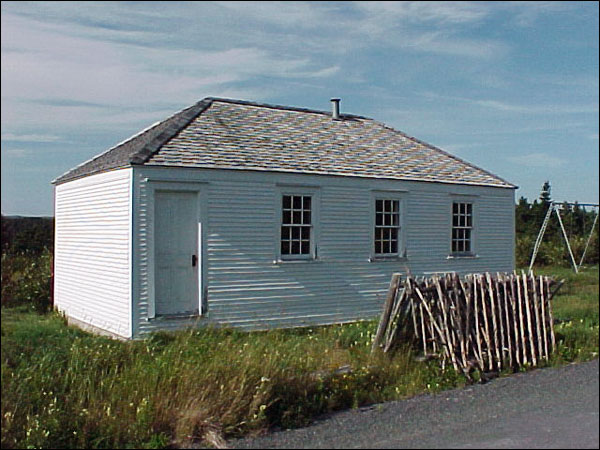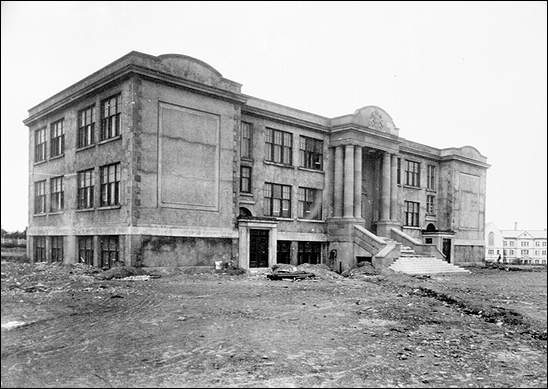Education
Public education in Newfoundland and Labrador, since its beginnings in the early 19th century, has largely been shaped by two factors: religion and the economy. The economy was based on a single industry, the fishery; the Protestant and Catholic churches, from 1843 onwards, dominated the educational system.
From the early 19th century until the 1930s, the revenue of Newfoundland governments consisted almost entirely of customs dues, which fluctuated with the state of the economy. Educational expenditure, therefore, had no solid basis in taxation, but was largely derived from a relatively limited and unstable source. This restricted the number and size of schools and facilities, and kept teachers' salaries at a very low level.
Religious Influence
Many of the independent schools of the decades before 1843, such as the St. John's Charity School, the Orphan Asylum School, various classical academies and the schools of the Newfoundland School Society, had been non-denominational. The schools of the public education system inaugurated by the first Education Act in 1836 also opened their doors to the children of parents of all creeds.

Very soon after the passing of the 1836 Act, however, Protestant forces, inspired by the militant Evangelical wing of the Church of England and drawing strength from the international "No Popery" crusade of the period, attacked the provisions of the Act, claiming that it excluded the Authorised Version of the Bible and gave too much influence to the Roman Catholics, who formed half of the population. The anti-Catholic campaign flowed over into the political arena and the British government, influenced by some highly-coloured stories of a possible Catholic revolution, passed the Newfoundland Act in 1842.
This restricted the franchise and established an Amalgamated Assembly of elected and appointed members in which the Catholics were in a minority. A Protestant-sponsored Education Act of 1843, in which the Catholics were forced to acquiesce, divided the education grant between Protestants and Catholics. This inaugurated the denominational system of education which, with additions and amendments, survived until nearly the end of the present century.
In the 1850s there was continuous activity on the education issue. The Church of England bishop, Edward Feild, was campaigning for a division of the Protestant education grant between the Church of England and the Methodists. Hugh Hoyles, a future Premier, put the case in Parliament year after year, but a strong feeling against further division frustrated his efforts.
The educational situation throughout the 1850s, '60s and early '70s was a continuing struggle to maintain adequate schooling on limited resources. Reports showed that the majority of schools were unsuitable, that teachers were undereducated and underpaid, that facilities and equipment were sadly lacking and that many school boards were inefficient. In 1858 the government passed a bill which increased the grant for education, instituted a system for the training of pupil-teachers in St. John's colleges and re-established the Inspectorship (dormant since 1845). These changes, however, did not take full effect until later in the century.
Bishop Feild and his supporters continued their campaign to sub-divide the Protestant grant. The Methodists opposed sub-division but in 1874, after complicated manoeuverings, Feild managed to persuade them to support the policy, although there was no widespread grass-roots support for it. In the preceding year a Select Committee had advocated radical reform of the educational system, including the establishment of a central educational department and a Normal School. The 1874 Act ignored these proposals and divided the Protestant grant between the Church of England and the Methodists. The possibility of reform was thus swamped by waves of sectarian antagonism.
A further Education Act in 1876 upgraded the post of Inspector to that of Superintendent. The three denominational Superintendents were given wide powers over all aspects of the running of the public elementary schools; in effect, government transferred most of what should have been its educational responsibilities to the churches. The three denominations lost little time in opening new schools (with the Methodists in the lead), often at the expense of teachers' salaries, which declined in the following decades.
Low Attendance Rates
By 1900, however, fewer than five out of every ten children between the ages of five and fifteen were attending elementary schools, and standards in the "Three Rs" were low. Expenditure on public elementary education was only five per cent of total government expenditure, the lowest since 1861. The curriculum in most schools consisted of reading, writing and arithmetic, plus some history and geography. To make matters worse, many certificated teachers were leaving the profession for more lucrative jobs.
There were, on the other hand, two significant advances in the period between 1890 and 1920 which did much to improve the situation. In 1893 the Council of Higher Education, an inter-denominational body, was formed with the primary purpose of setting examinations and devising appropriate curricula. In 1920 a Department of Education with a Minister was established.
Although the 1920s saw the creation not only of an Education Department, a Normal School and Memorial University College, the first third of the twentieth century was a period of stagnation as far as public schooling was concerned. The onset of the world economic crisis of 1929 had a devastating effect on Newfoundland education. In 1932-33 the education grant was cut by half to $500,000, effectively reducing teachers' salaries by the same proportion, and closing many schools. Shortly afterward, with the Dominion government nearly bankrupt, the institutions of responsible government were suspended and replaced by a London- appointed Commission in 1934.

Commission of Government
The Commission of Government, aided by subsidies from Britain, in its fifteen-year period of office, re-established the status quo of 1932-33, and went some way beyond it, increasing expenditure on education and the number of schools. It was unable, however, to accomplish its declared aim of instituting a state system of non-denominational schools because of the determined opposition of the churches.
The educational system which the Commission handed over to the newly-elected Liberal government after Confederation in 1949 was, despite some improvements, little different from that of the early part of the twentieth century. The great majority of the schools were small, wooden one-room, one-teacher institutions, and the hold of the churches on education was as strong as ever. The denominational system was entrenched in the Terms of Union under which Newfoundland joined Canada.
The first Liberal governments under Joseph Smallwood were, however, able to effect a veritable educational revolution. Aided by transfer payments and social security benefits from the Federal government, education at all levels was extended and upgraded. Improved communications, the construction of large central high schools, and a widespread bursary program, led to a flood of students entering the newly-founded Memorial University, whose Faculty of Education educated the teachers to staff the expanding number of schools. A network of Vocational Schools was also established.
In 1967-68 a Royal Commission on Education suggested improvements in the curriculum and the streamlining and rationalization of the denominational system. In 1968, the Pentecostal Assemblies were granted the same educational rights guaranteed under the Constitution as the Roman Catholic Church, the Anglican Church of Canada, the United Church of Canada and the Salvation Army. The formation of a single Consolidated Board by the major Protestant denominations followed shortly afterwards. By the mid-1970s the educational system had in most respects been brought up to national standards, although some weaknesses persisted.
If the quarter-century from 1949 was the golden age of Newfoundland education, the following period was one of relative decline. The economic situation worsened, transfer payments were reduced, educational expenditure decreased, and there was a significant change in the ideological climate.
Adapting to Economic Needs
The aims of education had traditionally fostered the development of the individual on the basis of the humanistic curriculum inherited from the Renaissance. However, the publication of two Royal Commission documents, Building On Our Strengths and Education for Self-Reliance in 1986 presented a radically different ideology. Newfoundland and Labrador was to go forward into a "post-industrial society", characterised by computerization, modern transport, high-technology and communication systems and a vibrant service sector. Education would upgrade "human capital", and training would be scientific, entrepreneurial, generic and flexible.
This adaptation of education to the needs of the economy, influenced by neo-liberal ideology of the American New Right, found full expression in Change and Challenge (1992), a document of the Liberal government of Clyde Wells. Education was seen as "the key to economic development"; the new aim of education was to produce a flexible workforce with an entrepreneurial outlook suitable to the new global economy. A Royal Commission on Education of the same year also embodied some of these ideas. Plans for the reform of the curriculum in line with these conceptions followed in 1994.
One other aspect of educational reform was on the agenda: to reduce or eliminate the power of the churches to control many aspects of education - in effect, to end the traditional denominational system. After protracted negotiations with, in particular, the Roman Catholic and Pentecostal Churches, who strongly opposed reform, and after two referenda in favour of change, the Liberal government of Brian Tobin finally passed the necessary legislation to form a non-denominational system, 155 years after the first denominational Education Act.




